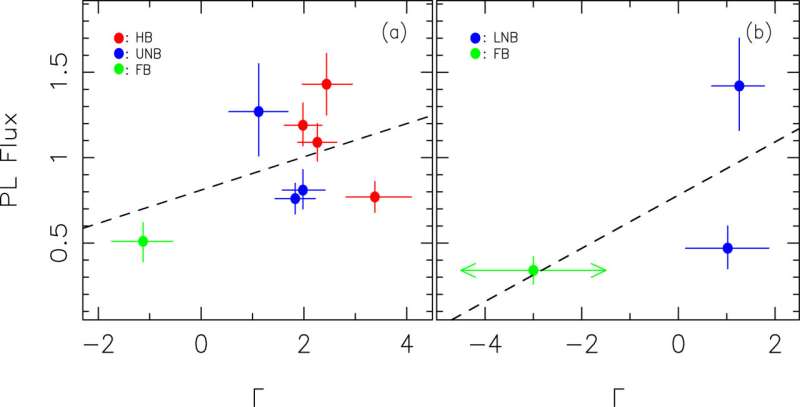This article has been reviewed according to Science X's editorial process and policies. Editors have highlighted the following attributes while ensuring the content's credibility:
fact-checked
peer-reviewed publication
trusted source
proofread
Researchers investigate hard X-ray emission of neutron star low-mass X-ray binaries

With the observational data of the Hard X-ray Modulation Telescope (HXMT), the first X-ray astronomical satellite of China, Dr. Ding Guoqiang from the Xinjiang Astronomical Observatory of the Chinese Academy of Sciences, along with his collaborators, investigated the hard X-ray tail of neutron star low-mass X-ray binaries (NS-LMXBs). Their results were published in The Astrophysical Journal on June 12.
In the past decades, observations of X-ray astronomical satellites have shown that the hard X-ray tail above about 30 keV in Z sources, classified to NS-LMXBs, is uncommonly detected. The effective area of the high-energy detector of HXMT is up to 5,000 cm2 and its observational data are very favorable for studying the hard X-ray tail of Z sources.
The researchers systematically analyzed and fitted the high-energy spectra of Scorpius X-1 (a Z source) in 30–200 keV, observed by HXMT, and found a power-law component in the high-energy spectra of eight observations.
Results showed that the power-law component of Sco X-1, called the hard X-ray tail, became hard and weak along the evolution track in the hardness-intensity diagram. The joint fitting of the broadband spectra (2–200 keV) suggested that the hard X-ray tail of Sco X-1 could be resulted from the up-scattering Comptonization of the X-ray photons emitting from the surface of the neutron star by the thermal electrons in the region between the neutron star and the accretion disk, and the energetic electrons in the free-fall toward the neutron star in the converging flow onto the neutron star.
"Our study proposed an alternative mechanism for hard X-ray tail producing in NS-LMXBs," said Dr. Ding.
More information: G. Q. Ding et al, Insight-HXMT Detections of Hard X-Ray Tails in Scorpius X-1, The Astrophysical Journal (2023). DOI: 10.3847/1538-4357/accf91
Journal information: Astrophysical Journal
Provided by Chinese Academy of Sciences



















